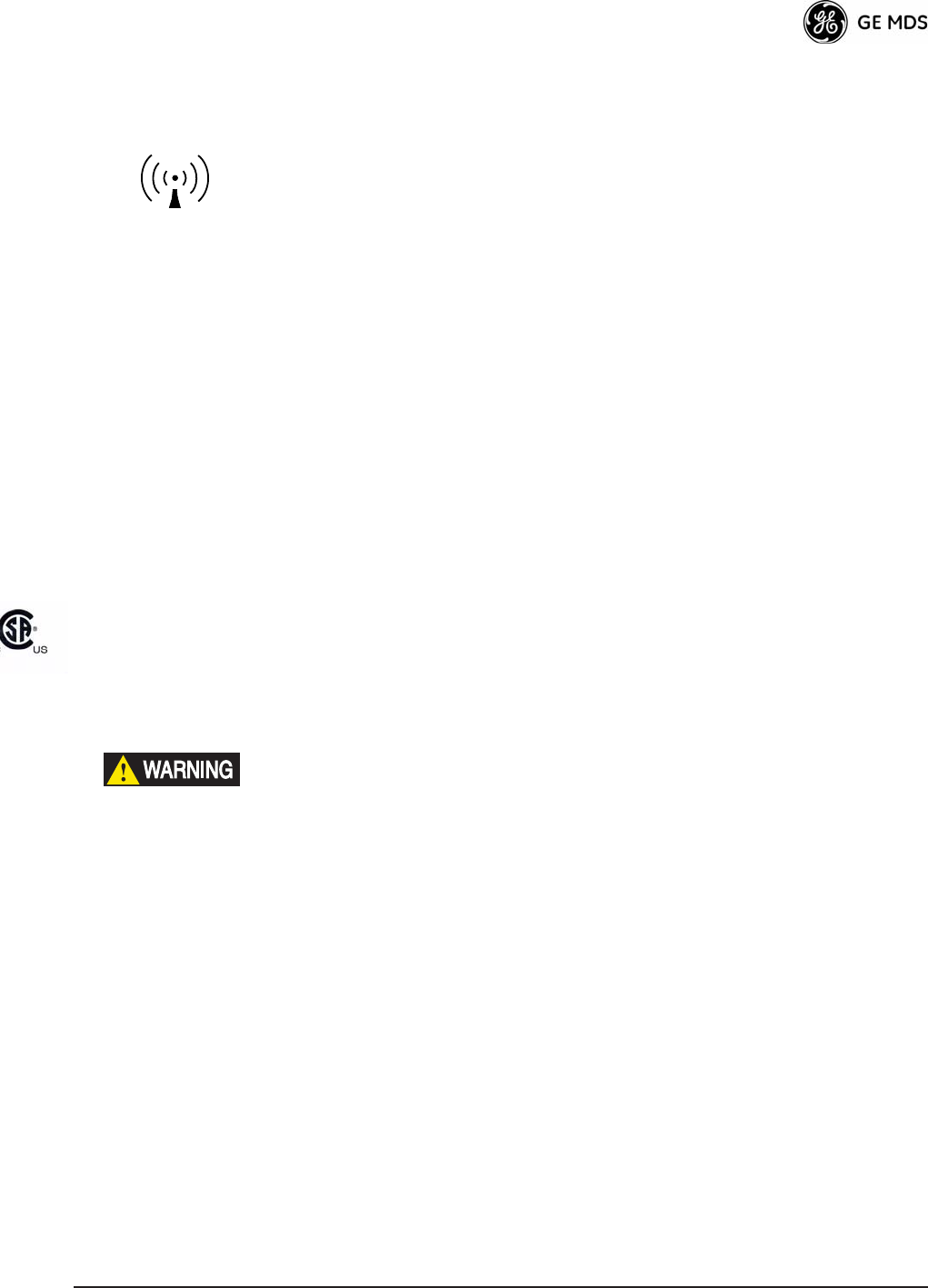GE MDS DS-MERCURY900 Mercury 900 Wireless Transceiver User Manual 4446A Mercury BodyTOC
GE MDS LLC Mercury 900 Wireless Transceiver 4446A Mercury BodyTOC
GE MDS >
Contents
User Manual 2

05-4446A01, Rev. A Mercury Reference Manual i
TABLE OF CONTENTS
1 PRODUCT OVERVIEW AND APPLICATIONS .......... 1
1.1 ABOUT THIS MANUAL.........................................................................................................3
1.1.1 Start-Up Guide ...........................................................................................................................3
1.1.2 Online Access to Manuals ..........................................................................................................3
1.1.3 Conventions Used in This Manual ..............................................................................................3
1.2 PRODUCT DESCRIPTION................................................................................................... 4
1.2.1 Model Offerings ..........................................................................................................................6
1.2.2 MDS P23 Protected Network (Redundant) Configuration ..........................................................7
1.3 APPLICATIONS .................................................................................................................... 7
1.3.1 Mobile/Fixed Data System .........................................................................................................7
1.3.2 Wireless LAN ..............................................................................................................................8
1.3.3 Point-to-Point LAN Extension .....................................................................................................9
1.3.4 Serial Radio Network Connectivity ..............................................................................................9
1.3.5 Multiple Protocols and/or Services
(Future Functionality) ..........................................................................................................................10
1.3.6 Wireless LAN with Mixed Services ...........................................................................................10
1.3.7 Upgrading Older Wireless Network with
Serial Interfaces (Future Functionality) ............................................................................................... 11
1.4 NETWORK DESIGN CONSIDERATIONS.......................................................................... 12
1.4.1 Extending Network Coverage with Repeaters ..........................................................................12
1.4.2 Protected Network Operation using Multiple Access Points .....................................................14
1.4.3 Collocating Multiple Radio Networks ........................................................................................15
1.5 GE MDS CYBER SECURITY SUITE.................................................................................. 16
1.6 ACCESSORIES .................................................................................................................. 17
2 TABLETOP EVALUATION AND TEST SETUP ....... 19
2.1 OVERVIEW......................................................................................................................... 21
2.2 STEP 1CONNECT THE ANTENNA PORTS ................................................................... 21
2.3 STEP 2MEASURE & CONNECT THE PRIMARY POWER ............................................ 22

ii
Mercury Reference Manual 05-4446A01, Rev. A
2.4 STEP 3CONNECT PC TO THE TRANSCEIVER............................................................ 23
2.5 STEP 4REVIEW TRANSCEIVER CONFIGURATION .................................................... 23
2.5.1 Getting Started .........................................................................................................................23
2.5.2 Procedure .................................................................................................................................23
2.5.3 Basic Configuration Defaults ....................................................................................................23
2.6 STEP 5CONNECT LAN AND/OR SERIAL EQUIPMENT ............................................... 24
2.7 STEP 6CHECK FOR NORMAL OPERATION................................................................. 25
3 EMBEDDED MANAGEMENT SYSTEM................... 27
3.1 MS INTRODUCTION .......................................................................................................... 28
3.1.1 Differences in the User Interfaces ............................................................................................28
3.2 ACCESSING THE MENU SYSTEM ................................................................................... 30
3.2.1 Methods of Control ...................................................................................................................31
3.2.2 PC Connection & Log In Procedures .......................................................................................31
3.2.3 Navigating the Menus ...............................................................................................................35
3.3 BASIC DEVICE INFORMATION......................................................................................... 36
3.3.1 Starting Information Screen ......................................................................................................36
3.3.2 Main Menu ................................................................................................................................38
3.3.3 Configuring Basic Device Parameters ......................................................................................39
3.4 CONFIGURING NETWORK PARAMETERS ..................................................................... 41
3.4.1 Network Configuration Menu ....................................................................................................41
3.4.2 IP Configuration Menu ..............................................................................................................42
3.4.3 Ethernet Port Configuration Menu ............................................................................................43
3.4.4 Bridge Configuration .................................................................................................................44
3.4.5 VLAN Configuration ..................................................................................................................45
3.4.6 SNMP Agent Configuration .......................................................................................................46
3.4.7 Wireless Network Configuration (AP Only)................................................................................49
3.4.8 AP Location Info Config Menu (Remote Only) ..........................................................................49
3.4.9 DHCP Server Configuration (AP Only) .....................................................................................50
3.4.10 SNTP Server Configuration ....................................................................................................51
3.5 RADIO CONFIGURATION.................................................................................................. 51
3.5.1 Radio Configuration Menu ......................................................................................................52
3.5.2 Frequency Control Menu ..........................................................................................................53
3.5.3 Advanced Configuration Menu .................................................................................................54
3.5.4 Security Configuration ..............................................................................................................55
3.5.5 Redundancy Configuration (AP Only) ......................................................................................61

05-4446A01, Rev. A Mercury Reference Manual iii
3.5.6 GPS Configuration (Remote Only) ...........................................................................................66
3.5.7 Performance Information Menu ................................................................................................66
3.5.8 Maintenance/Tools Menu .........................................................................................................74
3.6 PERFORMANCE OPTIMIZATION...................................................................................... 85
3.6.1 Proper OperationWhat to Look For .......................................................................................88
4 TROUBLESHOOTING & RADIO
MEASUREMENTS.................................................... 91
4.1 TROUBLESHOOTING........................................................................................................ 93
4.1.1 Interpreting the Front Panel LEDs ............................................................................................93
4.1.2 Troubleshooting Using the Embedded Management System ..................................................94
4.1.3 Using Logged Operation Events ..............................................................................................98
4.1.4 Alarm Conditions ......................................................................................................................98
4.1.5 Correcting Alarm Conditions ...................................................................................................100
4.1.6 Logged Events .......................................................................................................................101
4.2 RADIO (RF) MEASUREMENTS ....................................................................................... 103
4.2.1 Antenna System SWR and Transmitter Power Output ...........................................................103
4.2.2 Antenna AimingFor Directional Antennas ...........................................................................105
5 PLANNING A RADIO NETWORK .......................... 107
5.1 INSTALLATION PLANNING ............................................................................................. 109
5.1.1 General Requirements ...........................................................................................................109
5.1.2 Site Selection ......................................................................................................................... 110
5.1.3 Terrain and Signal Strength .................................................................................................... 111
5.1.4 Antenna & Feedline Selection ................................................................................................ 111
5.1.5 How Much Output Power Can be Used? ............................................................................... 114
5.1.6 Conducting a Site Survey ....................................................................................................... 115
5.1.7 A Word About Radio Interference ........................................................................................... 115
5.2 dBm-WATTS-VOLTS CONVERSION CHART.................................................................. 118
6 TECHNICAL REFERENCE...................................... 119
6.1 DATA INTERFACE CONNECTORS ................................................................................. 121
6.1.1 LAN Port .................................................................................................................................121
6.1.2 COM1 Port .............................................................................................................................122
6.2 FUSE REPLACEMENT PROCEDURE ............................................................................ 122
6.3 SPECIFICATIONS ............................................................................................................ 123

iv
Mercury Reference Manual 05-4446A01, Rev. A
6.4 NOTES ON SNMP............................................................................................................ 126
6.4.1 Overview ................................................................................................................................126
7 GLOSSARY OF TERMS & ABBREVIATIONS....... 131
Copyright Notice
This publication is protected by U.S.A. copyright law. Copyright 2007, GE MDS, LLC. All rights
reserved.
ISO 9001 Registration
Microwave Data Systems adheres to the internationally-accepted ISO 9001 quality system stan-
dard.
To our Customers
We appreciate your patronage. You are our business. We promise to serve and anticipate your
needs. We will strive to give you solutions that are cost effective, innovative, reliable and of the
highest quality possible. We promise to build a relationship that is forthright and ethical, one that
builds confidence and trust.
Related Materials on the Internet
Data sheets, frequently asked questions, case studies, applica-
tion notes, firmware upgrades and other updated information is available on the GE MDS Web site
at www.GEmds.com.
About GE MDS
Over two decades ago, GE MDS began building radios for business-critical applications. Since
then, we have installed thousands of radios in over 110 countries. To succeed, we overcame
impassable terrain, brutal operating conditions and disparate, complex network configurations. We
also became experts in wireless communication standards and system applications worldwide. The
result of our efforts is that today, thousands of utilities around the world rely on GE MDS-based
wireless networks to manage their most critical assets.
The majority of GE MDS radios deployed since 1985 are still installed and performing within our
customers’ wireless networks. Thats because we design and manufacture our products in-house,
according to ISO 9001 which allows us to control and meet stringent global quality standards.
Thanks to our durable products and comprehensive solutions, GE MDS is the wireless leader in
industrial automationincluding oil and gas production and transportation, water/wastewater
treatment, supply and transportation, electric transmission and distribution and many other utility
applications. GE MDS is also at the forefront of wireless communications for private and public
infrastructure and online transaction processing. Now is an exciting time for GE MDS and our cus-
tomers as we look forward to further demonstrating our abilities in new and emerging markets.
As your wireless needs change you can continue to expect more from GE MDS. We’ll always put
the performance of your network above all. Visit us at www.microwavedata.com for more infor-
mation.

05-4446A01, Rev. A Mercury Reference Manual v
OPERATIONAL & SAFETY NOTICES
CSA/
us
Notice (Remote Transceiver Only)
This product is approved for use in Class 1, Division 2, Groups A, B, C & D Hazardous Locations. Such locations are
defined in Article 500 of the National Fire Protection Association (NFPA) publication
NFPA 70
, otherwise known as
the National Electrical Code.
The transceiver has been recognized for use in these hazardous locations by the Canadian Standards Association
(CSA) which also issues the US mark of approval (CSA/
US
). The CSA Certification is in accordance with CSA STD
C22.2 No. 213-M1987.
CSA Conditions of Approval: The transceiver is not acceptable as a stand-alone unit for use in the hazardous locations
described above. It must either be mounted within another piece of equipment which is certified for hazardous
locations, or installed within guidelines, or conditions of approval, as set forth by the approving agencies. These
conditions of approval are as follows:
The transceiver must be mounted within a separate enclosure which is suitable for the intended application.
The antenna feedline, DC power cable and interface cable must be routed through conduit in accordance with the
National Electrical Code.
Installation, operation and maintenance of the transceiver should be in accordance with the transceiver’s installation
manual, and the National Electrical Code.
Tampering or replacement with non-factory components may adversely affect the safe use of the transceiver in haz-
ardous locations, and may void the approval.
A power connector with screw-type retaining screws as supplied by GE MDS must be used.
Do not disconnect equipment unless power has been switched off or the area is known to
be non-hazardous.
Refer to Articles 500 through 502 of the National Electrical Code (NFPA 70) for further
information on hazardous locations and approved Division 2 wiring methods.
FCC Part 15 Notices
The transceiver series complies with Part 15 of the FCC Rules. Operation is subject to the following two conditions:
(1) this device may not cause harmful interference, and (2) this device must accept any interference received, including
interference that may cause undesired operation. This device is specifically designed to be used under Section 15.247
of the FCC Rules and Regulations. Any unauthorized modification or changes to this device without the express
approval of Microwave Data Systems may void the users authority to operate this device. Furthermore, the Mercury
Series is intended to be used only when installed in accordance with the instructions outlined in this manual. Failure
to comply with these instructions may also void the users authority to operate this device.
Part 15 rules also require that the Effective Isotropic Radiated Power (EIRP) from a Mercury Series installation not
exceed 36 dBm. Refer to
Antenna & Feedline Selection
on Page 111 for more information.
Industry Canada RSS Notices
Operation is subject to the following two conditions: (1) this device may not cause interference, and (2) this device
must accept any interference, including interference that may cause undesired operation of the device.
To reduce potential radio interference to other users, the antenna type and its gain should be chosen so that the Equiv-
alent Isotropic Radiated Power (EIRP) is not more than that permitted for successful communication.
Professional installation required. The radio equipment described in this guide emits radio
frequency energy. Although the power level is low, the concentrated energy from a direc-
tional antenna may pose a health hazard. Do not allow people to come closer than 23 cm
(9 inches) to the antenna when the transmitter is operating in indoor or outdoor environ-
ments. More information on RF exposure is on the Internet at
www.fcc.gov/oet/info/documents/bulletins
.
RF Exposure
EXPLOSION
HAZARD!

vi
Mercury Reference Manual 05-4446A01, Rev. A
This device as been designed to operate with the antennas listed below, and having a maximum gain of 12 dB.
Antennas not included in this list or having a gain greater than 12 dB are strictly prohibited for use with this device.
The required antenna impedance is 50 ohms. Refer to Table 5-3 on Page 117 for a list of antennas acceptable for use
with this transceiver.
Manual Revision and Accuracy
This manual was prepared to cover a specific version of firmware code. Accordingly, some screens and features may
differ from the actual unit you are working with. While every reasonable effort has been made to ensure the accuracy
of this publication, product improvements may also result in minor differences between the manual and the product
shipped to you. If you have additional questions or need an exact specification for a product, please contact our Cus-
tomer Service Team using the information at the back of this guide. In addition, manual updates can often be found on
the GE MDS Web site at www.GEmds.com.
Environmental Information
The manufacture of this equipment has required the extraction and use of natural resources. Improper disposal may
contaminate the environment and present a health risk due to hazardous substances contained within. To avoid dissem-
ination of these substances into our environment, and to limit the demand on natural resources, we encourage you to
use the appropriate recycling systems for disposal. These systems will reuse or recycle most of the materials found in
this equipment in a sound way. Please contact GE MDS or your supplier for more information on the proper disposal
of this equipment.